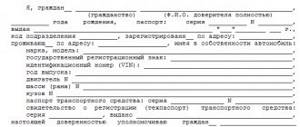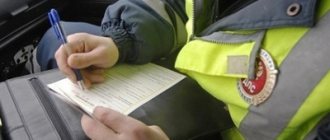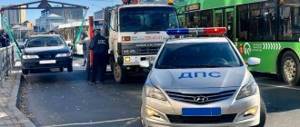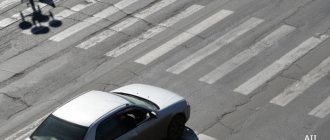The traffic rules, paragraph 2.1.2, state that a seat belt must be fastened for all passengers in the car before the vehicle moves off. For violators, punishment is provided in the form of a fine for not fastening a seat belt.
Collection of a fine for not fastening a seat belt in 2021 can be issued not only to the driver, but also to his passengers.
Attention! If you have any questions, you can chat for free with a lawyer at the bottom of the screen or call Moscow; Saint Petersburg; Free call for all of Russia.
When is the fine imposed?
A traffic inspector has the authority to issue a protocol for all violators of the rules for the safe operation of transport in accordance with the traffic rules (clause 2.1.2; clause 22.9). A fine for not wearing a seat belt in 2021 will be issued if:
- the driver did not use the belt;
- the conditions for travel in a car for a minor child under 12 years of age were violated;
- the passenger was not wearing a seat belt.
The car may be stopped by a traffic inspector for another reason, and non-compliance with the rules for using a safety structure is discovered later by a traffic police inspector. In such a situation, separate orders are issued for each violation.
When is it necessary to restrain your child?
Children under 7 years old are transported in special devices. A child under 12 years old, but over 7 years old, can be transported in the back in restraints or fastened with a standard seat belt. Previously, only teenagers over 12 years old were allowed to wear a seat belt.
If a child under 12 years of age is riding in the front, an appropriately sized child car seat is required. When purchasing this restraint device, you need to check whether it has a certificate. Such equipment includes boosters and car seats.
What is the fine for a driver and passenger not wearing a seat belt in 2021?
Administrative penalties for not wearing a seat belt in 2021:
- for the driver – 1 thousand rubles;
- for a passenger – 500 rubles.
In a situation where the requirements for travel of minors under 12 years of age in a car are not met, the fee increases to 3 thousand rubles. The fine for not fastening a seat belt, which the driver will have to pay, as well as the conditions for issuing it are stipulated in Art. 12.6 Code of Administrative Offences. Punishment for violating the rules for transporting children is specified in Art. 12.23 Code of Administrative Offences. Passengers are issued a protocol based on Article 12.29 of the Administrative Code.
What other liability can you face for not fastening your seat belt?
The situation may become even more complicated if an accident occurs due to the driver’s fault; in this case, you will have to answer for your unbelted passengers. Criminal liability arises, so the violator may face:
- if serious harm to health is caused, imprisonment for up to 2 years is possible, in addition, you will have to work in public or forced labor for 2 years and deprivation of rights for up to 3 years;
- if one of the participants in the accident is fatal, forced labor can reach 4 years, and you can end up behind bars for 5 years;
- If two or more people die, then forced labor may be imposed for up to 5 years, and deprivation of liberty - for 7 years.
In addition, injured passengers can file a civil claim if they suffered damages as a result of the accident. Therefore, buckle up yourself and remind other people in the car about this duty.
During the trial, an investigation will be conducted, all evidence will be considered and a penalty will be imposed in proportion to the act committed.
Fine for not wearing a seat belt in the back seat
When a passenger does not wear a seat belt while sitting in the back seat of a car equipped with seat belts, he still violates traffic rules. If this fact is discovered by the traffic police inspector, you will need to pay 500 rubles. An administrative penalty is issued against the passenger in accordance with Article 12.29 of the Administrative Code. In some situations, the inspector is limited to a written or oral warning.
If a car has safety structures installed on all seats, the passenger will need to buckle up no matter where he sits. For violation of the rule, the person driving in 2021 bears the same responsibility as the passenger. The fine for the driver in this case will be 1000 rubles. Therefore, representatives of the traffic police are empowered to issue a fine both to the one who is driving (Article 12.6 of the Code of Administrative Offences) and to all other unbelted citizens in the car (with the exception of minors) (Article 12.29 of the Code of Administrative Offenses).
Fine for a passenger without a seat belt 2021
As we mentioned above, passengers are also solely responsible for not wearing a seat belt while driving. Of course, you can cite some reasons why they may not be aware of this rule, such as:
- Passengers may not have a driver's license and therefore not know the rules of the road.
- Also, passengers may never have had to deal with driving or driving vehicles.
- Rare communication with traffic police officers and poor knowledge of fines are also one of the factors.
However, as we have already said, in this case, ignorance does not exempt from responsibility, therefore, if this violation is recorded, the passenger is obliged to pay part of the amount for the fine for the belt in 2021 in the amount of 500 rubles.
Fine for not fastening a seat belt for a child under 12 years old
The rules for transporting minors under 12 years of age are established in the Traffic Regulations, clause 22.9. The document states that a child can be transported in a car:
- in the front seat only in a special car seat;
- In special cases, it is allowed to transport minors in the rear when using adapters that will help securely secure the child with regular belts installed in the car.
Children under 7 years of age are transported only in a special car seat, no matter where they are, next to the driver or behind him. This rule has been introduced since 2021. Previously, it was allowed to use special locking devices in the rear seats.
If a child from 7 to 12 years old rides in the front seat, then you need to install a child car seat. Any other safety devices, including boosters, are prohibited in this situation. In case of violation, a protocol is drawn up for payment of 3 thousand rubles (Article 12.23 of the Administrative Code).
In 2021, the driver is also responsible in the case when a minor is in a car seat, but is not secured with a seat belt. If an offense is established, he faces a penalty of 3 thousand rubles.
Since May 2021, the bill has been amended, according to which penalties are imposed not only on the driver, but also on the official or legal entity responsible for organizing group trips for minors. The fine is 25 thousand and 100 thousand rubles, respectively (Article 12.23 of the Administrative Code). If several preschoolers are transported in a vehicle, then a car seat is installed for each.
A quarter of Russians do not wear seat belts in their cars
The question of who should be subject to fines in the event that a vehicle passenger is not fastened in a car also yielded very interesting results. In the regions, the majority believes that the responsibility lies entirely with the passenger and it is he who must be charged a fine. Muscovites are much more loyal to passengers on this issue, and the opinion of regional respondents is shared by only 13 percent of the capital’s residents.
It should be noted that in this case, female drivers showed themselves to be more disciplined. They use belts 76 percent of the time, compared to men only 63 percent. It is also important to note the fact that in the capital there is a higher percentage of those who buckle up in the back seat of a car.
Fine for not wearing seat belts
Paragraph 2.1 of the traffic rules states that in 2021 the driver is required to wear a restraint device, just like his passengers. If the condition is not met, the traffic police inspector fills out a protocol on the administrative violation. However, it happens that the design of the car was not originally designed to contain these elements. This occurs on older models where the manufacturer did not install restraint devices for the rear and front seats. In this situation, a fine for not wearing a belt would be unlawful.
In the case where the device was independently dismantled by a motorist, when the car is stopped by an inspector in 2021, a penalty of 500 rubles may be imposed (Traffic Regulations clause 7.9, Code of Administrative Offenses Article 12.5 clause 1). The inoperability of the retaining elements or visible severe damage is also considered an administrative offense (Traffic Regulations clause 7.10). If at the same time the driver transports passengers who are not wearing seat belts, then he may be issued a report for this violation.
Buses and minibuses on intercity routes are required to be equipped with restraint devices. If the design is missing, then an administrative penalty will be issued to the driver. Its amount is 500 rubles (Traffic Regulations clause 7.9, Code of Administrative Offenses art. 12.5 clause 1). Sometimes the inspector is limited to only a warning. The officials responsible for releasing the bus onto the line, in the absence of a holding structure or its malfunction, are subject to an administrative penalty of 25,000 rubles (Administrative Code Art. 12.31).
Rules for using seat belts
Driver seat belt
2.1. The driver of a motor vehicle is obliged to: ... 2.1.2. When driving a vehicle equipped with seat belts, be fastened and do not carry passengers who are not wearing seat belts.
Paragraph 2.1.2 of the traffic rules clearly stipulates 2 points for which the driver of a car equipped with seat belts is responsible:
- the driver himself must be wearing a seat belt;
- The driver must ensure that all passengers are wearing seat belts.
Please note that if your vehicle is equipped with seat belts, you cannot carry unbelted passengers.
The traffic rules require you to wear seat belts only when the car is moving, but I recommend wearing your seat belts immediately after getting into the car, even if you are not going to drive. This is due to the fact that traffic accidents with stationary cars occur quite often. And in this case, the belt will help you avoid injury.
Passenger seat belt
5.1. Passengers are obliged to:
- when traveling in a vehicle equipped with seat belts, be wearing them, and when riding a motorcycle, wear a fastened motorcycle helmet;
The rules for using seat belts for passengers are even simpler than for the driver. The passenger is only obliged to ensure that he himself is fastened with a seat belt.
After boarding someone else's vehicle, be sure to buckle up . The passenger cannot be sure how the driver will behave. In this case, the belt will help protect against unpleasant consequences for life and health in the event of an accident.
This also applies to public transport: city taxis and intercity buses. Often in such vehicles the belts are partially or completely removed. However, if the vehicle still has belts, be sure to use them. I hope that your bus or taxi will not get into an accident, but a seat belt can at least protect you from moving around the cabin during sudden maneuvers for which public transport drivers are famous.
Child seat belt
Children, like other passengers, must be wearing seat belts or in a special child seat. In this case, the choice of a belt or seat depends on the age of the child, as well as on the seat on which the child is riding. This issue is discussed in more detail in a separate article:
Rules for transporting children in a car
In general, the rules for using belts look like this. If your car has seat belts, you should wear .
Who pays the fine for a passenger not wearing a seat belt?
The traffic rules, paragraph 2.1.2, state that in 2021 both the driver and passengers in a moving vehicle must wear seat belts. Violation of the rule entails administrative liability.
At the same time, clause 5.1 of the traffic rules obliges the passenger to use seat belts, if they are installed. Otherwise, the citizen may be fined or issued a warning.
Thus, in 2021, responsibility for the offense lies both with the passenger himself and with the one who is driving. The amounts of administrative penalties vary. A protocol is drawn up for the person driving the car, indicating 1 thousand rubles (Article 12.6 of the Administrative Code). For passengers, the punishment will be only half of this amount - 500 rubles (Article 12.29 of the Administrative Code). The penalty against the driver is issued once, regardless of how many unbelted people are in the car. In this case, protocols can be issued for each violating passenger.
In minibus taxis, the seats next to the driver are usually equipped with restraint devices. When driving on them, it is mandatory to wear a restraint device. If the rule is violated, a protocol on administrative penalties may be issued for both passengers and the person driving. The seats in the cabin are equipped with seat belts only on intercity routes. In such a situation, the passenger must also fasten his seat belt, as specified in paragraph 5.1 of the traffic rules.
Does the camera record the presence of a seat belt on the driver?
Most installed surveillance systems are focused on recording such cases:
- crossing the prohibition line,
- running a red light,
- determination of vehicle speed.
The lack of video recording makes high-quality filming unlikely, so it can hardly be called irrefutable. It is possible to determine whether a driver is wearing a seat belt only when he stops at a traffic light. When the front window of a car is slightly tinted, it is almost impossible to capture the driver without a seat belt on camera. This factor can be played to advantage in the courts.
In order to be able to hold the driver accountable for this offense by providing video footage, it is necessary to have a high-quality photograph of the person behind the wheel, his passengers and the license plate number of the car. If the pictures are of poor quality or are completely absent, it will be very difficult to prove the guilt of the offender.
When can you drive without wearing a seat belt?
Until 2010, the traffic rules (clause 2.1.2) provided for several situations when it was allowed not to wear a seat belt in a moving vehicle. These included:
- The driving instructor did not have to wear a seatbelt during the driving lesson.
- Officers of the operational services may not use seat belts, but identification marks must be placed on their car.
- Passengers sitting in the rear can ride without a belt if it is not originally provided in the model.
But by Government Decree No. 316 of May 10, 2010, amendments were made to the traffic rules and clause 2.1.2. The first two groups of people who were previously allowed not to wear seat belts were excluded from it. In 2021, you can not use a seat belt only if it is not provided for by the design of the car (clause 2.1 and clause 5.1 of the traffic rules).
The traffic rules stipulate that the restraint device is used both on urban roads and in rural areas. The intensity of the movement does not affect the obligation to use it.
Pregnant women should also wear a seatbelt in 2021. The legislation does not provide special conditions for the use of a restraint device for this category. It is recommended to fasten the seat belt in such a way that it cannot damage the fetus during sudden braking and pressure on the abdomen.
Procedure for imposing a fine
A traffic police officer issues a fine for not fastening a seat belt if drivers violate traffic rules. In 2021, the procedure for initiating an administrative penalty case is regulated by Art. 28.1 Code of Administrative Offences.
The procedure for receiving a ticket for not wearing a seat belt in 2021 is as follows:
- The inspector has the right to stop the car if he notices a violation.
- An offense under clause 2.1 and clause 5.1 of the traffic rules is recorded directly by an official who has the authority to do so.
- The inspector must explain to the offender the reason for stopping him and present documents.
- The traffic police officer draws up a protocol, on the basis of which a decision on an administrative offense is made.
- The document indicates all the circumstances of the case: information about the driver and vehicle, information about the violation, etc.
- The protocol is drawn up in two copies, one for the violator, the other remains for the inspector.
- In a special column, the driver must write whether he agrees or not with the data specified in the protocol.
- If the violator has no complaints about the preparation of the document, then he is given a copy of the resolution and a receipt for payment of the fine.
In cases where a driver is accused of not wearing a seat belt, evidence in the form of photographs or videos is not required. This violation in 2021 can be established based on a visual inspection by a vehicle inspector. But if there are photo and video materials, they can become additional evidence of the driver’s guilt.
Can another driver be at fault if he was not wearing a seat belt?
For this reason alone, unfortunately, no. The fact is that the very fact of violating the Rules regarding failure to fulfill the obligation to fasten a seat belt, in principle, cannot cause an accident. And the obligation to compensate for damage resulting from an accident falls precisely on the person whose violation led to this accident, and the totality of all violations is not simply considered.
For example, the first driver did not give way to the second at an uncontrolled intersection or drove through a red traffic light. In this case, other things being equal, 100% of the blame will fall on the first participant.
And the fact that the other person was not wearing a seat belt, although it can play a bad joke on him during proceedings in the consequences of an accident, will in no case shift the blame onto him.
Here we need to distinguish between types of incidents in the context of the topic we are discussing (we will discuss them separately below).
- The driver, through whose fault the accident occurred, was not wearing a seat belt - everything is obvious here: it is your own fault, and you must answer for it yourself!
- The first participant in the accident was found to be at fault, but the second was driving without a belt, and there was no harm to health.
- The first driver was at fault for the accident, but the second driver was driving without a seat belt, as a result of which he suffered (that is, harm not only to cars, but also to health).
- The first one is to blame, the second one similarly did not have a belt, which is why the harm to health turned out to be greater than it would have been if he had been driving with a belt on.
- And there are individual cases where unbelted passengers were injured as a result of culpable actions that resulted in an accident by one or the other driver.
Let's take a closer look at these cases!
What should a driver do if he is fined for not wearing a seat belt in 2021?
When a traffic police inspector stops a vehicle, you should first ask to present identification documents (Section 2.4 of the Traffic Regulations). If the driver agrees with the violation, then he waits for the protocol to be drawn up, after which he signs it, and subsequently pays the specified amount.
A driver who has not violated traffic rules can indicate in the protocol that he does not agree with the actions of the traffic police officer. Having a dual-camera DVR in your car will help the driver prove his innocence. If the inspector insists on a violation, and there is no documentary evidence to the contrary, then the motorist can file a complaint with higher authorities to challenge the fine for not wearing a seat belt.
Some drivers refer to Art. 1.5 of the Code of Administrative Offenses on the “presumption of innocence”. But in practice, it is the vehicle owners who prove in court that they did not violate traffic rules, and not vice versa.
Challenging a fine
So, let’s imagine a situation - the driver and passenger are not wearing seat belts and are moving around in a car. The traffic police inspector stops her, draws up a report, and then issues a fine.
It would seem that the situation is clear, but it happens that the driver does not agree with the actions of the inspector. Under such circumstances, he must clearly understand how to challenge them.
- To begin with, you can file a complaint with the senior management of the department to which the employee is assigned. This is not easy to do. The fact is that when challenging such actions, the driver must provide a recording from a double DVR. This is a device, one camera of which films the interior, and the other records the traffic situation.
The traffic police officer does not have to provide a video recording to prove the driver’s guilt. The absence of one is not a compelling argument.
- Another way to express disagreement with the actions of the inspector is to prove the fact of a biased attitude towards the driver. If indecent behavior of a traffic police officer is recorded on camera (screaming, threatening, calling the driver names), liability may be withdrawn.
One of the frequent points of contention is the timing of unfastening the seat belt. The driver usually claims that he removed it after stopping the car. However, if this was not recorded by a video camera, it will be impossible to prove this fact. It is strongly recommended not to unfasten your seat belt even if you have stopped the car - wait until the traffic police officer approaches.
Is there a discount on the fine?
The amount of the fine for not wearing a seat belt can be reduced only by quickly fulfilling your obligations. If no more than 20 days have passed since the decision on an administrative violation was issued, then its amount is reduced by 2 times. In other words, in the first days after the violation was detected, only 50% can be paid (Article 1 of Law No. 437-FZ of December 22, 2014).
If the driver does not agree with the written protocol, he can appeal it within 10 days (Article 30.3 of the Code of Administrative Offenses of the Russian Federation). If the car owner does not do this, he will need to pay the fine in full within 2 months.
Appeal
You can appeal the actions of a traffic police officer in court in the following order:
- Draw up a statement of disagreement with the written protocol.
- Prepare evidence of your innocence (witness testimony, photos or videos, etc.).
- Take the application with attachments to the court or addressed to the head at the place of duty of the traffic police officer who issued the fine for not wearing a seat belt. Documents can be sent by registered mail through the post office.
- Wait for a response to the complaint. The traffic police must consider the application within 10 days (Article 30.5, paragraph 1 of the Administrative Code). The court examines the case materials after receiving them for 2 months (Article 30.5, paragraph 1.1 of the Administrative Code).
In order for the case to be resolved in favor of the plaintiff, the application must be correctly drawn up. In 2021, it should contain the following information:
- name of the judicial authority where the documents are submitted;
- information about the applicant (full name, address);
- detailed description of the situation;
- information about the vehicle that was stopped;
- references to laws that confirm the plaintiff’s case;
- indication of documentary evidence of the absence of an offense;
- date of preparation of the paper and personal signature.
The document must be drawn up in an official business style. It is not allowed to use colloquial words, obscene expressions, or curses. The application is submitted to the court office, where a mark indicating its acceptance is made. Next, a date and time will be set for a hearing, at which the plaintiff must attend in person. If this is not possible, a representative of the applicant who has a notarized power of attorney may appear at the meeting.
Applications to appeal a fine for not wearing a seat belt can be found here.
How to avoid a fine for not wearing a seat belt in 2021?
To draw up a protocol under Art. 12.6 of the Code of Administrative Offenses, the inspector only needs to visually detect a violation. A traffic police officer can issue a fine without video or photography. Therefore, even if the driver disagrees with the existence of an offense, the inspector has the right not to provide documentary evidence.
The main reason for canceling a fine is the incorrect filling out of the protocol by a traffic police officer, so you should carefully study the document. If it contains incorrect information about the driver or vehicle, the violator has the right to appeal against its preparation.
If you disagree with the fine issued for not wearing a seat belt in 2021, the motorist has the right to appeal to a higher authority within 10 days. The complaint can be sent to the traffic police department at the inspector’s place of duty, the court or the prosecutor’s office.
You can avoid a fine for not wearing a seat belt on the following grounds:
- The structure failed, and the driver went to a service station to have the problem fixed.
- The driver and passengers unfastened their seat belts after the vehicle stopped.
- Manufacturers initially did not provide for the installation of the device in this model.
If the seat belts were removed directly by the owner of the car, then a fine cannot be avoided.
The driver can provide the inspector with evidence that he is right. If the traffic police officer does not agree with this, he will still issue a resolution, against which the motorist can file a complaint with the court within 10 days.
How to appeal a fine
Appeal procedure. You can file a complaint against a fine decision within the first 10 days from the date of the document. The complaint will have to be sent by regular mail to the regional traffic police department.
If the complaint is rejected, you can go to court. Before doing this, we recommend that you contact a lawyer who will file a claim.
Sample complaint. In your application please indicate:
- addressee - the position and name of the head of the traffic police department, whose employee issued the protocol. It can be clarified by phone on the document or you can simply send a complaint to the regional head of the inspection;
- your details - name and phone number;
- circumstances - when and where the inspector recorded the violation and why you do not agree with it;
- a request to cancel the decision;
- applications that prove innocence.
Sample application to appeal a fine from a camera
Nuances
- Both the driver and the passenger are responsible for failure to comply with traffic rules, so the traffic police officer can fine both of them for not wearing a seat belt.
- For driving without a seatbelt, the person driving the car is given a fine of 1,000 rubles, and the passenger is given a fine of 500 rubles or a warning. It does not matter where he was, in the front or back seat.
- A fine for a passenger is grounds for punishing the driver, regardless of whether he was wearing a seat belt or not.
- To determine an administrative violation, a resolution of an official entitled to do so is sufficient.
- You have 10 days to appeal a fine for not wearing a seat belt.
Judicial practice shows that the court is most often on the side of traffic inspectors. In order to challenge the fine, the driver will need to present compelling evidence of his innocence.
Failure to fasten a seat belt may also result in criminal liability in the event of an accident. Before starting the vehicle, the driver must ensure that everyone in the vehicle is using restraints. If he did not do this, then he violated the traffic rules, which will be taken into account when considering the case of an accident if there are victims. Any passenger who was injured during an accident can file a petition with the court to prosecute the driver. Depending on the circumstances, the person driving the car and causing the accident may be sentenced from 2 to 7 years in prison.
The driver is responsible not only for himself, but also for his passengers. A fine for not wearing a seat belt in 2021 is the minimum penalty. In the event of an accident, a restraint system can save lives and minimize injuries.
Iron protection from paying a fine
Numerous auto forums are full of advice from car enthusiasts not only on how to challenge a fine for a belt in the authorized bodies, but also what methods can be used to avoid punishment directly when meeting with an inspector. Let's consider the most effective action algorithms in detail:
- -A probationary offender has the right to demand from the inspector the presentation of photographs and videos that recorded his guilt. If such evidence is absent, this indicates that the traffic rules on the road were not violated. In the event that a traffic police officer notices an unfastened seat belt, the driver’s objections are based on the stationary state of the vehicle, since the legislation of the Russian Federation obliges the use of a protective device exclusively during a trip.
- -If the inspector stands his ground, then it is necessary to insist on drawing up a protocol. In the “explanations” section, write the text: “I cannot agree with the violation presented, because while driving the car, according to the instructions, I fixed the safety strap over my shoulder. The inspector could not impartially and objectively prove my guilt.” Based on the information of the regulatory legal act of the current legislation, the traffic police officer must collect evidence of the guilt of the motorist or passenger in a particular violation. Otherwise, there are no legal grounds for prosecution.
- -You can confirm your non-involvement in the charges using data from a video recorder equipped with two security cameras. In this case, one of them will show the movement or parking of the vehicle, and the second will record video information about the driver’s actions at the same time. This is an undeniable basis for the court to terminate the consideration of the case regarding the collection of a fine.
- -If a negative consequence cannot be avoided, and a writ of execution has been issued, you can challenge the fine for a seat belt with the help of an experienced motor vehicle lawyer.
The main criterion based on which you can protest a monetary penalty for not fastening your seat belt is documentary evidence. A person driving a car can challenge the enforcement document of the traffic police, citing the use of passive protection while the vehicle is moving. Witness testimony may serve as confirmation.










